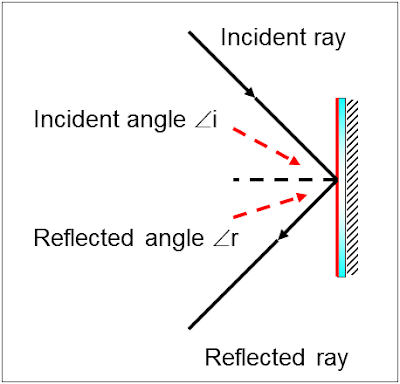This worksheet show's how light is refracted through different perspex/glass blocks
May 17, 2011
3.17 Refraction of light, Experiments
Describe experiments to investigate the refraction of light, using rectangular blocks, semicircular blocks and triangular prisms.
This worksheet show's how light is refracted through different perspex/glass blocks
This worksheet show's how light is refracted through different perspex/glass blocks
3.16 Plane Mirrors
For an object reflected in a plane mirror, the image is...
- The same size as the object
- The same distance as the object from the mirror.
- Virtual (not real)
- Upright
- Laterally Inverted
3.15 Angles of Incidence and Reflection
Recall that the angle of incidence equals the angle of reflection.


This image shows that both angles are equal.
This diagram shows the position of the angles and that they are measured from the normal.

3.14 Light waves
Light waves are transverse waves which can be reflected, refracted and diffracted

Reflection of light: The change in direction of a light wave so that it returns into medium from which it originated
Refraction of light: The bending of light,when it passes between materials of different density e.g from air to perspex:
Diffraction of light: Light Waves spreading into the shadow when they pass the edge or through a slit.
3.13 effects of excessive exposure to the human body
Recall the detrimental effects of excessive exposure of the human body to electromagnetic waves, including
Microwaves: Internal heating of body tissue
Infrared: skin burns
Ultraviolet: Damage to surface cells and blindness
Gamma rays: cancer, mutation
Microwaves: Internal heating of body tissue
Infrared: skin burns
Ultraviolet: Damage to surface cells and blindness
Gamma rays: cancer, mutation
3.12 Uses of Electromagnetic Radiation
Recall some of the uses of electromagnetic radiations
Radio waves
- Broadcasting and communications
Microwaves
- Cooking and satellite transmissions
Infrared
- Heaters and night vision equipment
Visible light
- Optical fibres and Photography
Ultraviolet
- Fluorescent lamps
X-rays
- observing the internal structures of objects and materials and medical applications
Gamma Rays
- Sterilising food and medical equipment
Radio waves
- Broadcasting and communications
Microwaves
- Cooking and satellite transmissions
Infrared
- Heaters and night vision equipment
Visible light
- Optical fibres and Photography
Ultraviolet
- Fluorescent lamps
X-rays
- observing the internal structures of objects and materials and medical applications
Gamma Rays
- Sterilising food and medical equipment
May 10, 2011
3.11 The Order of the Electromagnetic Spectrum
The Diagram bellow clearly shows the 7 parts of the E-M spectrum in order of decreasing wavelength, from left to right

An easy way to remember the order is with a mnemonic
For example for the E-M spectrum (RMIVUXG)
you could have:
Reading Music Is Very Unsatisfactory for Xylophones and Glockenspiels
and for the visible portion of the spectrum (ROYGBIV)
Richard Of York Gave Battle In Vain
Or just make up your own...
3.10 The Electromagnetic Spectrum
3.10 Understand that light is part of a continuous electromagnetic spectrum which includes radio, microwave, infrared, visible, ultraviolet, x-ray and gamma ray radiations and that all these waves travel at the same speed in free space.
The speed that the electromagnetic waves travel at in a vacuum (free space) is 299,792,458 m/s which is often rounded to 3.00 x 108 m/s
The speed that the electromagnetic waves travel at in a vacuum (free space) is 299,792,458 m/s which is often rounded to 3.00 x 108 m/s
May 2, 2011
3.9 Diffraction through gaps
Understand that waves can be diffracted through gaps, and that the extent of diffraction depends on the wavelength and the physical dimension of the gap
When a wave is sent through a gap it is diffracted on both sides as shown below:
When the wavelength is equal to the width of the slit, the most diffraction will occur:
3.8 Diffraction
Understand that waves can be diffracted when they pass an edge.
What is Diffraction?
Diffraction refers to various phenomena which occur when a wave encounters an obstacle.
It is described as the apparent bending of waves around small obstacles and the spreading out of waves past small openings. (en.wikipedia.org/wiki/Diffraction)
Basically: Waves spreading into the shadow when they pass the edge
What is Diffraction?
Diffraction refers to various phenomena which occur when a wave encounters an obstacle.
It is described as the apparent bending of waves around small obstacles and the spreading out of waves past small openings. (en.wikipedia.org/wiki/Diffraction)
Basically: Waves spreading into the shadow when they pass the edge
3.7 Using the previous relationships
Use the below relationships in different contexts, including sound waves and electromagnetic waves
Examples:
1. A certain sound wave has a frequency of 170 hertz (cycles per second) and a wavelength of 2 metres.
What is the speed of sound?
2. The time period of a waves, T, is the time taken to produce one complete wave.
If the frequency of a wave is 2Hz, what is its time period?
Practice makes Perfect.
Subscribe to:
Posts (Atom)



